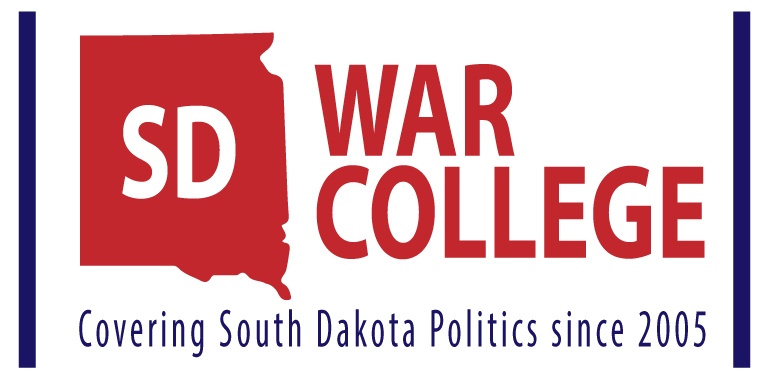I shouldn’t read Gordon Howie’s blog when crazy headlines pop up, because I just feel stupider when I’m done. Gordon spends most of his time hating on the political party that he abandoned when he threw his ally Stace Nelson under the bus and announced as an independent for US Senate.
Admittedly, I had to look when I saw the headline blaring “Daugaard Donations Tied To Syrian Refugees.” So I looked. And as usual, I’m just dumber for the effort to click.
I kind of knew what I was going to get when I noted the author of the article, Bob Ellis. Anymore, Bob spends many of his waking hours being an @$$hole to Republicans after Gordon predictably lost this last election. Bob’s website used to be interesting, even when saying we need to believe in Rambo Jesus, but since last year, he spends most of his time in blind idolatry of Gordon Howie.
Reading the article, Ellis finds himself quickly lost in his specious declaration when the sole link to the Daugaard connection to Syrian refugees is…. (cue ominous music…..dum dum duuuum….) Daugaard accepted political donations from former DSS director and Daugaard Administration advisor Deb Bowman, current LSS CEO Betty Oldenkamp, and former state senator Russ Olson… because they’re involved with Lutheran Social Services!
Umm, what? I mean, they’re not as cool as Catholic organization members (said me in a smirking manner), but I don’t think that means they’re trying to fill the state with Syrian refugees. In fact, I’d challenge Bob to name any Syrian refugees they’ve imported into South Dakota? But God forbid Bob come up with anything that isn’t completely whack-a-doodle.
Bob tries to use his calumny against Daugaard to lecture the world on who is and is not a Republican. If Bob wants to lecture us on who is Republican, and who isn’t, I’d argue that the imagined connection between Governor Daugaard and Syrian Refugees is far less provable than his own false idol Gordon Howie’s connection with Teamsters, the Soros Family, and Democrat PACs from this past election. Because a PAC connected with Howie this past election took money from all of them.
And it was a lot of money. Over $100,000 when it was said and done.
As I’d noted in great detail this past election, this past year, a PAC was formed to support the candidacy of Gordon Howie, ran by Howie confederate Gary Coe, called “Many True Conservatives.” And if you look at their expenditures, in the FEC Report below, Many True Conservatives spent nearly every dime to promote the candidacy of Gordon Kenneth Howie.
Many True Conservatives 2014 4q FEC
Where did this PAC get their money? Well, if you look at the report, they took in nearly all of their money (Over $108,000 total) from a single source – Every Voice Action. Don’t remember them? They came in late in the game, and were reported on briefly by David Montgomery at the Argus Leader. In reference to their support of Rick Weiland:
Every Voice Action received $1.58 million through Sept. 30. It’s received another $665,000 in the past two weeks.
Who are these donors? The biggest ones are other groups.
For example, the better-funded Mayday PAC gave $458,000 to its comrade in the fight against Mike Rounds.
Another group, “Friends of Democracy IE,” was even more generous. It gave $1.15 million to Every Voice. Donnelly is the treasurer of Friends of Democracy, another Super PAC founded “to end Super PACs.” Hopping over to Friends of Democracy’s FEC page, we can see it’s been primarily funded by a famous name: Soros.
In particular, it’s been given most of its money by Jonathan Soros, son of the famous financier (and liberal donor) George Soros. This election cycle, Jonathan Soros gave Friends of Democracy $1.5 million. George Soros gave it another $250,000; other George Soros children Andrea Soros and Alex Soros gave $250,000 and $375,000. It also got a lot of money from Napster founder and Facebook investor Sean Parker ($245,000), Google engineer Matt Cutts ($285,000), Kathleen McGrath of Encino, Calif. ($100,000), and John Pritzker of the Pritzker family.
Back to Every Voice Action. It’s also received $100,000 from CWA Working Voices, the independent expenditure arm of the Communication Workers of America; $100,000 from former Stride Rite president Arnold Hiatt; $50,000 from Cutts; $50,000 from private equity billionaire Jerome Kohlberg; and $50,000 from early Google employee David DesJardins. Other donors gave it less than $50,000; I’ll list them all at the bottom.
It also got an in-kind donation of $11,427.42 from the House Majority PAC, a PAC devoted to helping House Democrats. That was listed as being shared polling costs in districts where Every Voice Action is backing Democratic congressional candidates.
Read that here.
So if Ellis is going to come up with some nutty and false connection and lecture Republicans on Daugaard taking “Syrian Refugee Money” because of someone’s taking money from employees and board members for LSS, then he’d damned well better man up, and apply the same standards to the man on whose website he’s writing for – and admit the Howie PAC’s acceptance of money from labor unions, Democrat PAC’s and the Soros Family.


 District 30 South Dakota Representative Lance Russell of Hot Springs is bringing forth a bill that would dedicate revenue from video lottery for the purpose of supplementing teacher salaries in the state and establishing a teacher salary enhancement fund.
District 30 South Dakota Representative Lance Russell of Hot Springs is bringing forth a bill that would dedicate revenue from video lottery for the purpose of supplementing teacher salaries in the state and establishing a teacher salary enhancement fund.
 The Fight to Repeal Obamacare
The Fight to Repeal Obamacare
 Repeal and Replace Obamacare
Repeal and Replace Obamacare
 Fueled By South Dakota
Fueled By South Dakota